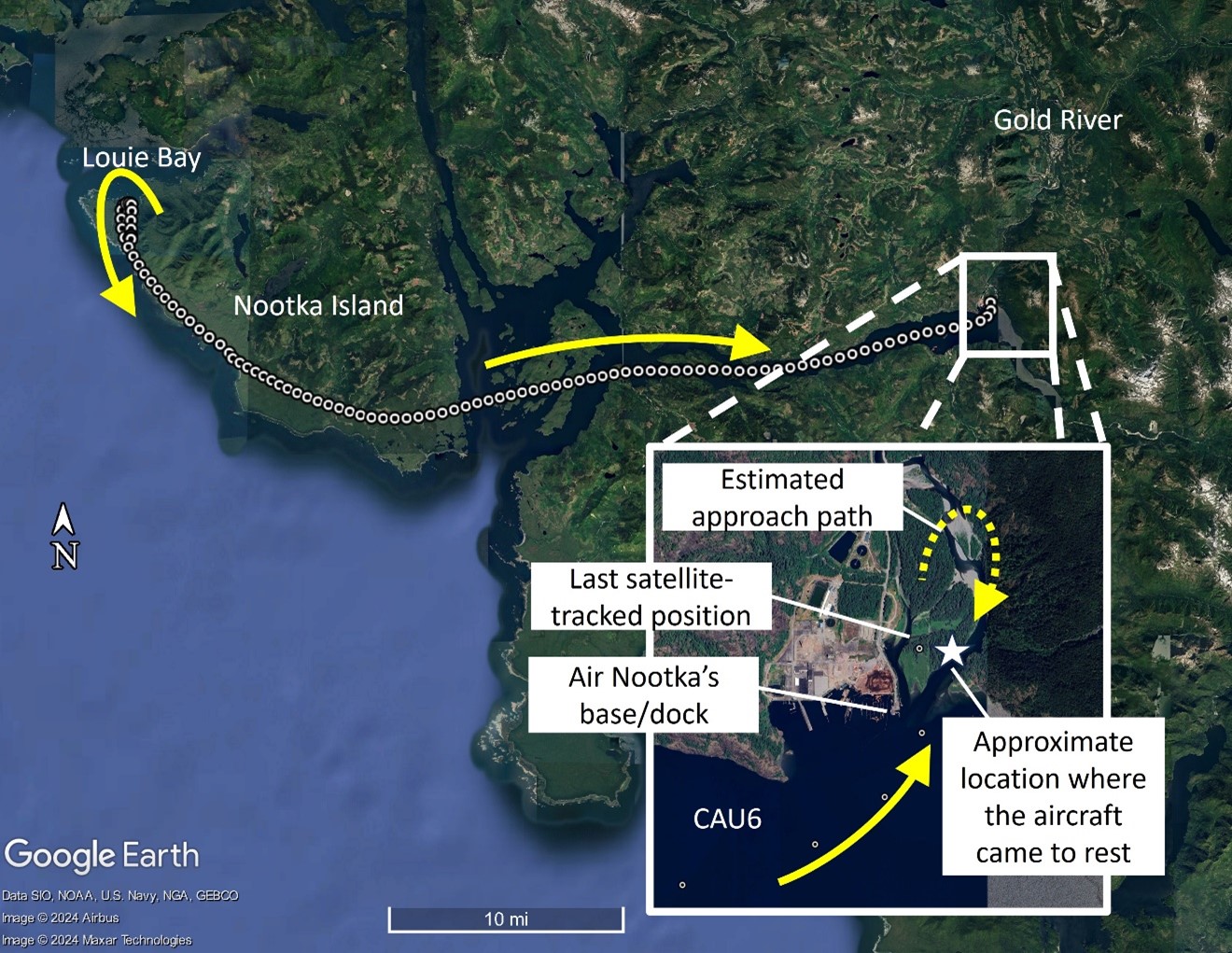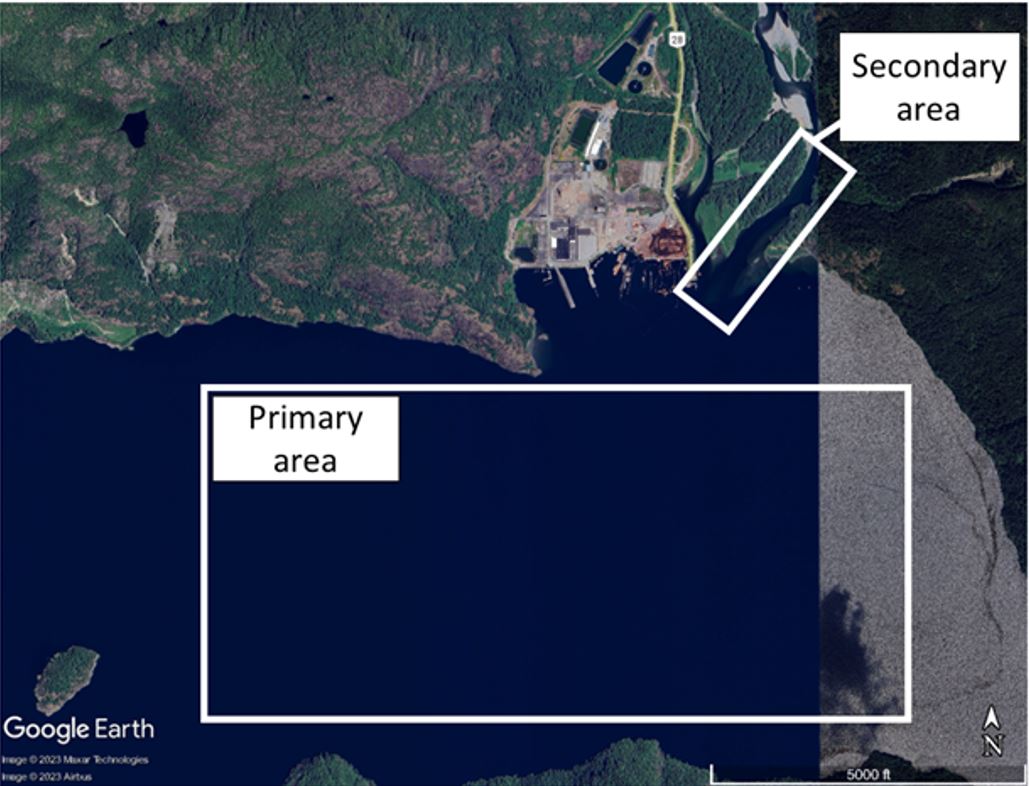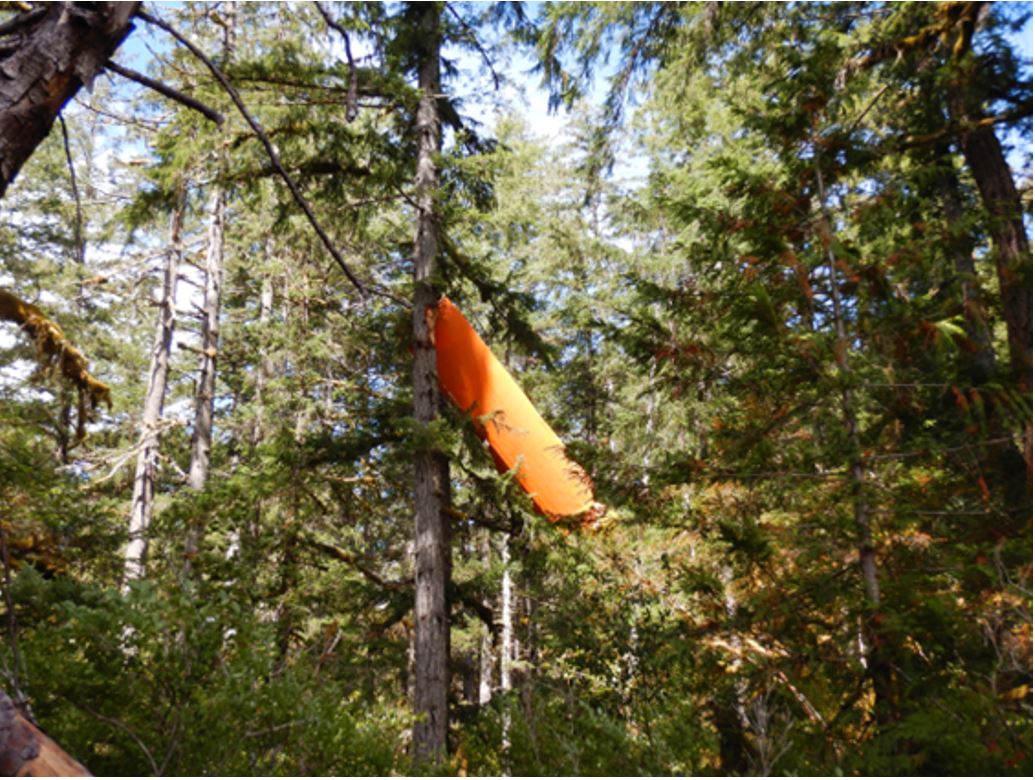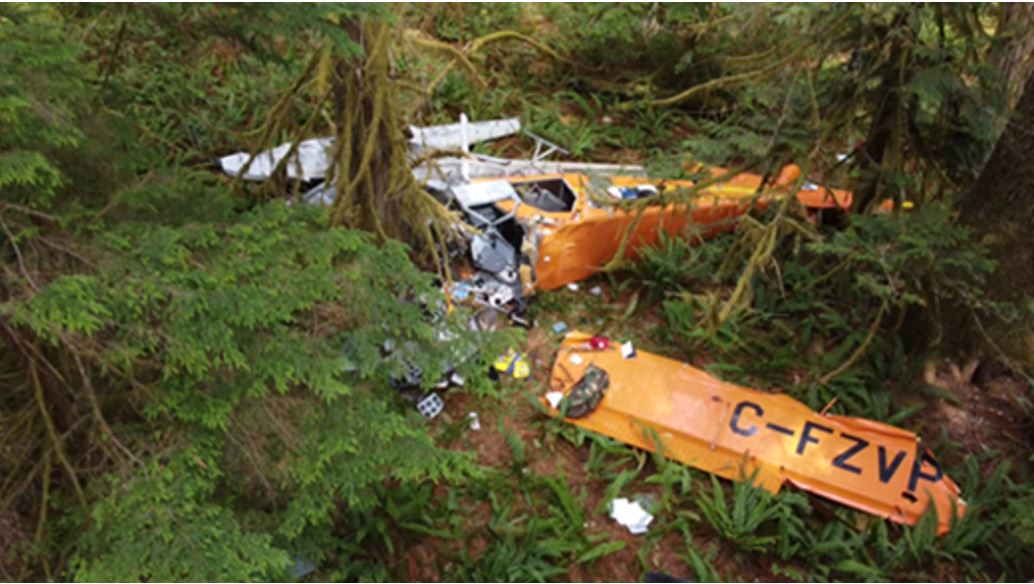Collision with terrain
Air Nootka Ltd.
De Havilland DHC-2 Mk. I (Beaver), C-FZVP
Gold River Water Aerodrome, British Columbia
The Transportation Safety Board of Canada (TSB) investigated this occurrence for the purpose of advancing transportation safety. It is not the function of the Board to assign fault or determine civil or criminal liability. This report is not created for use in the context of legal, disciplinary or other proceedings. See Ownership and use of content. Masculine pronouns and position titles may be used to signify all genders to comply with the Canadian Transportation Accident Investigation and Safety Board Act (S.C. 1989, c. 3).
History of the flight
On 28 July 2023, the Air Nootka Ltd. (Air Nootka) De Havilland DHC-2 Mk. I (Beaver) aircraft (registration C-FZVP, serial number 1033) was conducting a visual flight rules repositioning flight from Louie Bay on Nootka Island, British Columbia (BC), to Gold River Water Aerodrome (CAU6), BC, with only the pilot on board. On arrival at CAU6, the pilot noted a rough sea state in the company’s primary landing area and elected to land in the secondary area, a tree-lined river to the east of the base. The aircraft was observed overflying the company dock to the north and then turning right, aligning with the southwest direction of the river. When descending on the alignment turn to final approach, the aircraft experienced an uncommanded yaw and roll. It abruptly turned further right, heading west, and continued to descend toward the trees. It was reported that opposite aileron input, to try and arrest the uncommanded yaw and roll, increased the roll rate. At approximately 1720,All times are Pacific Daylight Time (Coordinated Universal Time minus 7 hours). the aircraft struck the forested area on the west side of the river, coming to rest approximately 75 feet from the river (Figure 1). There was no post-impact fire. The pilot received serious injuries, was extracted by local firefighting personnel, and attended to by local paramedics. He was then airlifted to hospital by a search and rescue helicopter.

Pilot information
The pilot held a Canadian commercial pilot licence – aeroplane, endorsed for landplanes and seaplanes, and a valid Category 1 medical certificate; the licence and ratings were appropriate for the flight in accordance with existing regulations. At the time of the occurrence, the pilot had acquired over 10 000 flight hours in floatplane and coastal operations. He had flown with Air Nootka for over 4 years and had completed all recurrent training and ground school courses by 18 June 2023. His last competency check was carried out on 29 June 2023.
According to information gathered during the investigation, there was no indication that the pilot’s performance was affected by medical or physiological factors.
Weather information
The nearest aviation weather reporting stations are located at the Campbell River Airport (CYBL), BC, 38 nautical miles (NM) northeast of CAU6; the Tofino/Long Beach Airport (CYAZ), BC, 32 NM south-southeast; the Comox Airport (CYQQ), BC, 48 NM east; and the Nanaimo Airport (CYCD), BC, 92 NM east-southeast. The aerodrome routine meteorological reports (METARs) valid at 1700 on 28 July 2023 (approximately 20 minutes before the occurrence) indicated favourable conditions for the flight and landing.
In addition to the METARs, an automated marine weather observation was taken at 1700 on 28 July at Estevan Point weather station (CWEB), BC, approximately 25 NM southwest of the occurrence location. It also indicated general conditions to be favourable.
The coastal geography and features can complicate coastal weather forecasting. The location of the occurrence is situated on an inlet that can, for example, funnel the prevailing winds, increasing their speed well above the surrounding areas.Environment and Climate Change Canada, The wind in your sails (09 July 2013), p. 12.
Aerodrome information
CAU6 is a registered water aerodrome located at Muchalat Inlet, BC, on the Pacific Ocean, approximately 7 NM south-southwest of the town of Gold River, BC. It is situated at the mouth of the Gold River, surrounded by heavily forested areas and rising terrain, and oriented on an east-west axis. The bay is more than 10 000 feet long and over 5000 feet wide at its midpoint.
Prevailing winds are from the west or southwest in the summer. The operator reported that the preferred takeoffs and landings are typically conducted in the primary area, toward the west. The Canada Water Aerodrome Supplement notes that at CAU6, “[w]ater can be extremely rough in a strong inflow wind condition.”NAV CANADA, Canada Water Aerodrome Supplement (effective 20 April 2023 to 21 March 2024), p. B69.
When the sea state is undesirable, the operator’s recommendation for takeoff and landing is to use the southwest portion of the Gold River mouth (marked as the secondary area in Figure 2), which provides approximately 1700 feet of surface. This secondary area may be shielded from the winds affecting the inlet, but the winds aloft in this area, as noted by the operator, have been observed to be unpredictable (Figure 2).

The company’s operations manual provides no specific guidance on the landing procedure for the secondary area; however, separate from the operations manual, the company does have recommended procedures and best practices for flight operations at many of its locations, including that of the occurrence.
Aircraft information
The occurrence aircraft was manufactured in 1956. There were no recorded defects outstanding at the time of the occurrence. The investigation determined that the weight and centre of gravity were within the prescribed limits. An initial physical examination of the aircraft was conducted on site and a second examination of the aircraft was conducted after the wreckage had been recovered. There was no indication that a component or system malfunction played a role in this occurrence.
The occurrence aircraft was not equipped with a stall warning system,A stall warning system is a device that provides a clear and distinguishable stall warning to the pilot that is independent of the pilot’s recognition of inherent aerodynamic qualities near the stall, such as buffeting. nor was it required to be by regulations.
Wreckage and impact information
Based on examination and photographs of the site, the aircraft was proceeding westbound when it struck the trees. The aircraft’s right wing separated from the aircraft and lodged in a tree (Figure 3).

The aircraft continued into the wooded area while rolling to approximately 90° of bank before impacting a large tree and coming to rest. The damage to the aircraft and the wreckage trail were indicative of a steep angled descent with low forward velocity, consistent with a stall.
The 3-blade propeller was significantly damaged, with 1 blade being ejected from the propeller assembly. All blades showed chordwise scratches with bending patterns consistent with an engine producing power at the time of impact.
Many of the flight instruments and engine gauges were significantly damaged as a result of the impact, and their examination provided little information useful to the investigation. Flight controls and associated linkages were examined, and no indications of failure before impact were noted. The observed damage was either consistent with impact or attributable to the recovery of the aircraft. There were no indications of a loss of control due to mechanical failure before impact.
Although the aircraft was significantly damaged, all major components were accounted for at the accident site (Figure 4).

A Spidertracks satellite-based flight tracking unit was aboard the aircraft and was functioning at the time of the occurrence. Although the flight tracking unit provided flight position information, the frequency of position reports was approximately once every 15 seconds and, therefore, it did not assist investigators in understanding the final seconds of the flight.
A Garmin GPSMAP 296 device was found at the site and sent to the TSB Engineering Laboratory in Ottawa, Ontario, for examination and data recovery. However, the memory chip was too damaged to recover any data.
The aircraft was fitted with an ACK Technologies, Inc. (Model E-04) automatic fixed emergency locator transmitter (ELT) designed to transmit on 406 MHz and 121.5 MHz. It had been installed behind the aft passenger bulkhead and was found intact in its mounting bracket. The transmitter did not activate during the occurrence. The ELT was sent to the TSB Engineering Laboratory for examination. It was determined that the spring mechanism in the inertia switch was off-centred and in contact with its casing; however, it could not be determined if this occurred during the manufacturing process or from the impact sequence. It could not be determined if the impact velocity was strong enough to activate the ELT.
Aerodynamic stall
While on the right turn to final, the aircraft experienced an uncommanded yaw and roll. The application of aileron in the opposite direction made the condition worse. This is consistent with an aerodynamic stall.
An aerodynamic stall occurs when a wing’s angle of attack exceeds the critical angle at which the airflow begins to separate. When a wing stalls, the airflow breaks away from the upper surface and the amount of lift will be reduced to below that needed to keep the wing flying. While stalls occur at a given angle of attack, they can happen at any speed.
The speed at which a stall occurs depends on several things, including the load factor, the weight of the aircraft, and the centre of gravity.
According to the DHC-2 flight manual, the “stall is gentle at all normal conditions of load and flap and may be anticipated by a slight vibration, which increases as flap is lowered.”Viking Air Limited, Product Support Manual (PSM) 1-2-1, DHC-2 Beaver Airplane Flight Manual, Revision 11 (08 July 2002), Section IV: Operating limits, performance data and flight characteristics, paragraph 4.11.5, p. 42. However, during a stall, “[i]f yaw is permitted, the aircraft has a tendency to roll. Prompt corrective action must be initiated to prevent the roll from developing.”Ibid. The manual also states “[i]n tight turns, flight load factors may reach the limit loads, and may also increase the danger of an unintentional stall.”Ibid., paragraph 4.6.1, p. 36.
Flight tests completed during certification of the DHC-2 type in the 1940s determined that the aerodynamic buffeting near the stall was a clear and distinctive stall warning. Because this was deemed to have met the design requirements, no further device or stall warning system was mandated to be installed.
In practice, very few aircraft types still in commercial operation today were type-certified without a stall warning system. The few types remaining in commercial operation, including the DHC-2, were certified before 1960.
Although the occurrence aircraft design did not originally include a stall warning system, such a system subsequently became available with the release of an approved modification (MOD 2/973) from Viking Air Limited, which is the current holder of the DHC-2 type certificate. Viking Air Limited has also designed an improved modification (MOD 2/1605) to the previously offered stall warning system that provides a visual and aural warning of an impending stall.
In October 2013, in the conclusion of TSB Aviation Investigation Report A12O0071, the Board included a safety concern that the aerodynamic buffet of DHC-2 aircraft alone may provide insufficient warning of an impending stall. The TSB noted accidents caused by an aerodynamic stall, as well as the catastrophic consequences of these accidents when they occur at low altitude and during critical phases of flight.
In late June 2014, Viking Air Limited published a technical bulletin recommending that stall warning systems be installed or enhanced on all DHC-2s via MOD 2/1605.Viking Air Limited, Technical Bulletin V2/00001: Installation of Improved Stall Warning System (30 June 2014). In addition, Transport Canada (TC) published a Civil Aviation Safety Alert in 2014 in which it also recommended that all DHC-2 airplane owners incorporate MOD 2/1605 or another approved artificial stall warning system.Transport Canada, Civil Aviation Safety Alert No. 2014-02: Installation in DHC-2 aeroplanes not originally equipped of an artificial stall warning system (17 July 2014), at tc.canada.ca/en/aviation/reference-centre/civil-aviation-safety-alerts/installation-dhc-2-aeroplanes-not-originally-equipped-artificial-stall-warning-system-civil-aviation-safety-alerts-casa-no-2014-02 (last accessed on 31 May 2024).
In August 2017, along with the release of TSB Aviation Investigation Report A15Q0120, involving a DHC-2 Mk. I aircraft that stalled during a low-altitude turn while on a sightseeing flight, the Board recommended that
the Department of Transport require all commercially operated DHC-2 aircraft in Canada to be equipped with a stall warning system.
TSB Recommendation A17-01
In its December 2019 response, TC indicated that it had completed an in-depth study to determine the most effective means of addressing the risks associated with stall-related accidents in DHC-2 aircraft. TC concluded that it would not require all commercially operated DHC-2 aircraft in Canada to be equipped with a stall warning system and reaffirmed its position in its December 2020 response. No further action was planned by TC in connection with this recommendation.
Even though a stall warning system would not likely have prevented an accident in all the cases studied by TC, a clear indication of an impending stall increases the pilot’s situational awareness and reduces the likelihood of a loss of control in flight. However, TC concluded that “[i]n these configurations, even with a stall warning system installed, a stall occurs and gives the pilot little to no time to react and recover.”Transport Canada, December 2019 response to TSB Recommendation A17-01, at www.tsb.gc.ca/eng/recommandations-recommendations/aviation/2017/rec-a1701.html (last accessed on 15 July 2024). The TSB does not agree with this statement.
To reduce the risk of losing control of an aircraft, the pilot must have an immediate, clear indication of an impending stall. The aural, and sometimes visual, signal of an impending stall emitted by a stall warning system means it is one of the last lines of defence against an accidental stall.
As stated in March 2022 in the TSB’s most recent assessment of TC’s response, until TC establishes new measures to address the risks associated with stall-related accidents in DHC-2 aircraft, the Board believes that the risks associated with the safety deficiency identified in Recommendation A17-01 remain.
Therefore, the Board assessed the response to Recommendation A17-01 as Unsatisfactory.TSB Recommendation A17-01, Stall warning systems – DHC-2, Reassessment of response to Aviation Safety Recommendation A17-01, at tsb.gc.ca/eng/recommandations-recommendations/aviation/2017/rec-a1701.html (last accessed on 31 May 2024).
Survival aspects
The pilot was found inside the cockpit of the aircraft, with the lap strap and shoulder harness attached and buckled. The livable space within the cockpit was badly deformed, indicating high deceleration forces at impact.
TSB laboratory reports
The TSB completed the following laboratory reports in support of this investigation:
- LP117-2023 – NVM Recovery – Various
- LP133-2023 – Seat Belt Analysis
- LP013-2024 – ELT Analysis
Safety messages
Flying approaches into areas restricted by terrain or obstacles can provide limited opportunity to recover if unpredictable winds require corrective inputs. Pilots need to be keenly aware of their margin of safety from an aerodynamic stall and ensure they maintain appropriate airspeed.
Aircraft originally certified without stall warning systems can benefit from aftermarket systems when they are available. Stall warning systems can reduce the risks pilots face when flying manoeuvres at higher angles of attack, such as arrivals and departures.
This report concludes the Transportation Safety Board of Canada’s investigation into this occurrence. The Board authorized the release of this report on 26 June 2024. It was officially released on 22 July 2024.